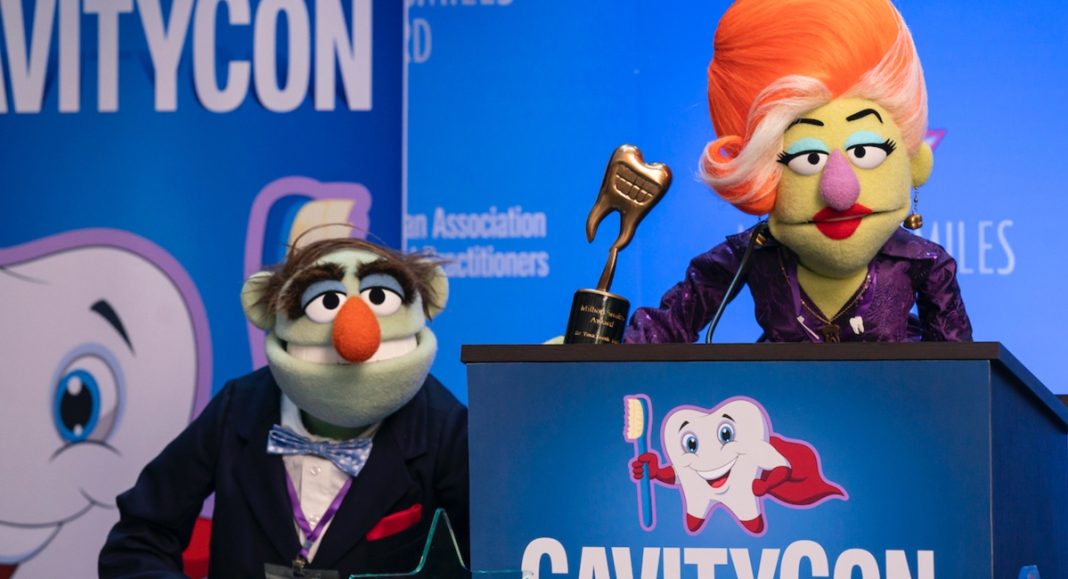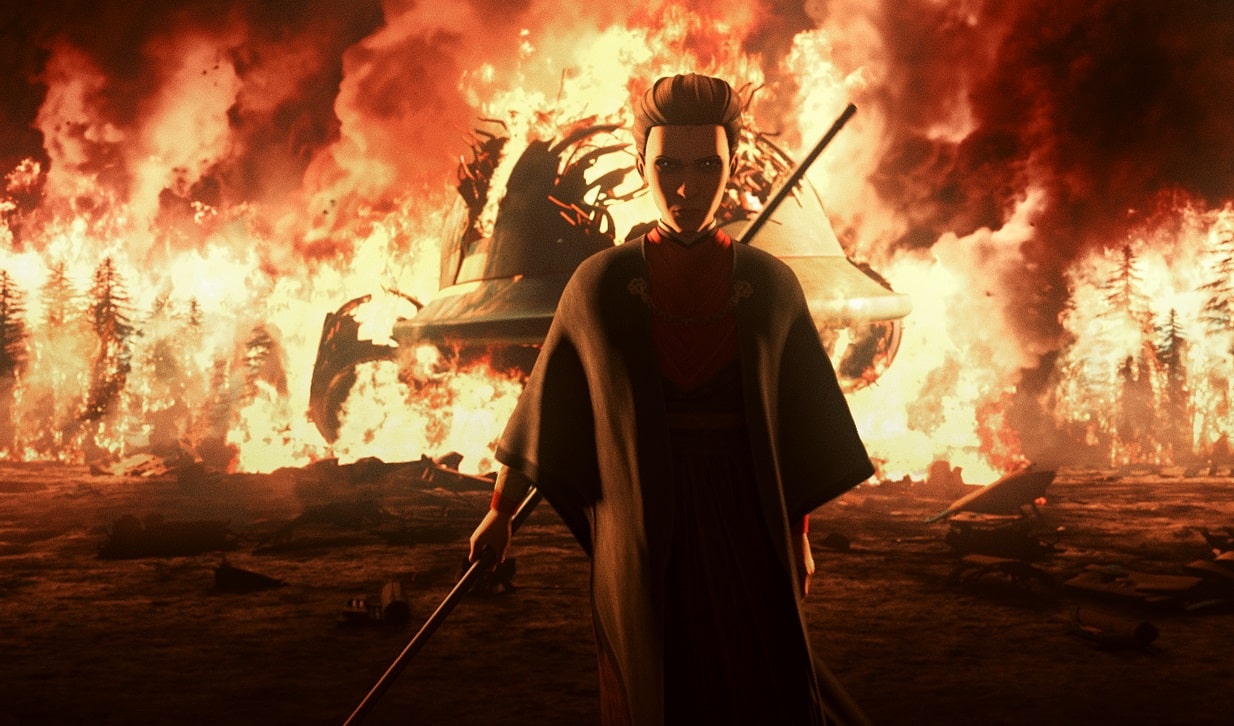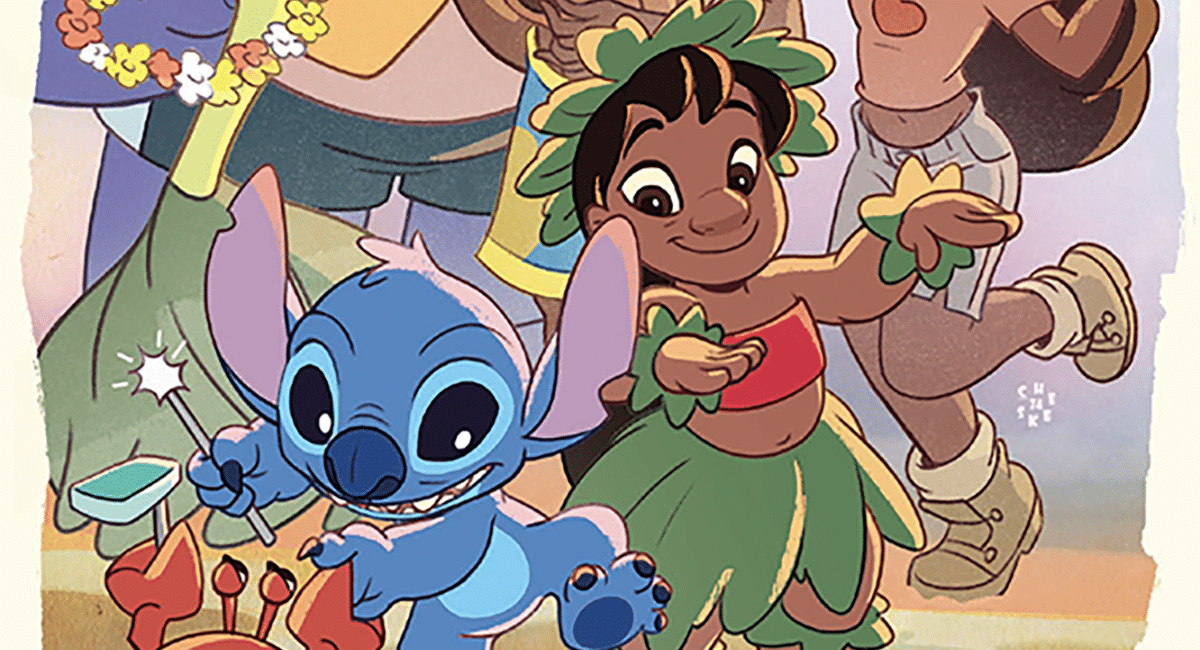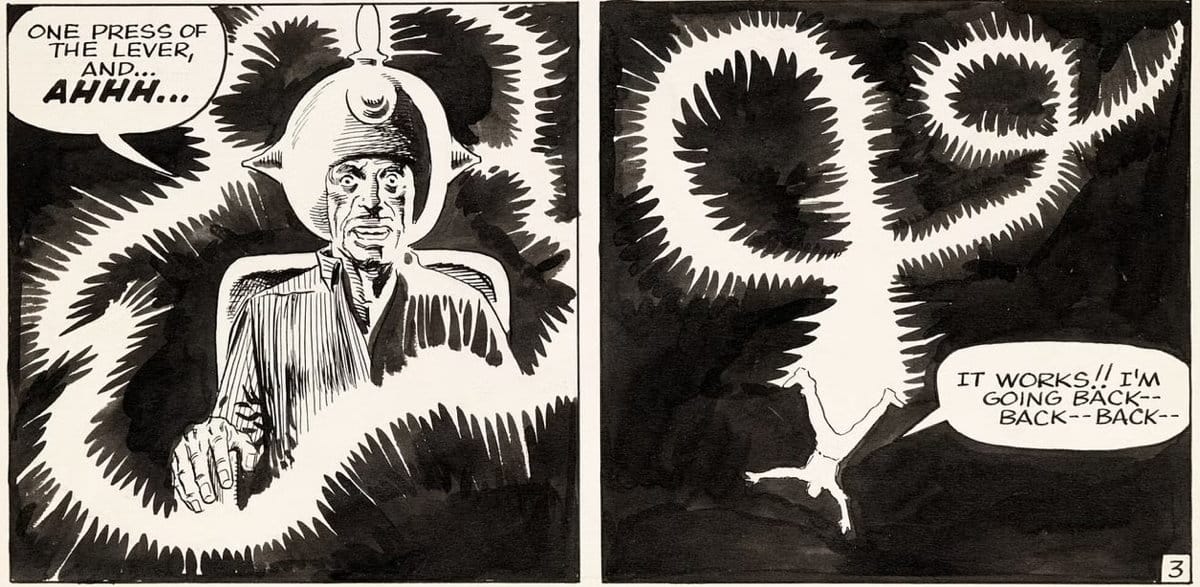It’s rare that the Jim Henson Creature Shop debuts a brand-new Muppet. But in the new Disney+ show, The Muppers Mayhem, which premiered on the streamer on May 10, Waffles + Mochi’s Restaurant alum David Bizzaro, a first-generation American Latinx actor, fashion designer, and Emmy Award-winning puppeteer, introduced Muppets fans to Dr. Teeth’s (Bill Barretta) dad, Gerald Teeth.
Bizzaro’s character, Gerald, is a dental hygienist with a sweet combover and a penchant for lawn photography. He also manages dental practice run by his wife, Tina Teeth (played by Avenue Q alum Stephanie D’Abruzzo), the original Dr. Teeth.
The Beat caught up with Bizzaro over the phone to discuss how he got into puppetry and landed the role of Gerald Teeth, his new clothing line (in part, inspired by Count Von Count), and working with Wayne Coyne of The Flaming Lips. Read on as this puppetry noob tries to understand the world of below-the-frame puppetry.
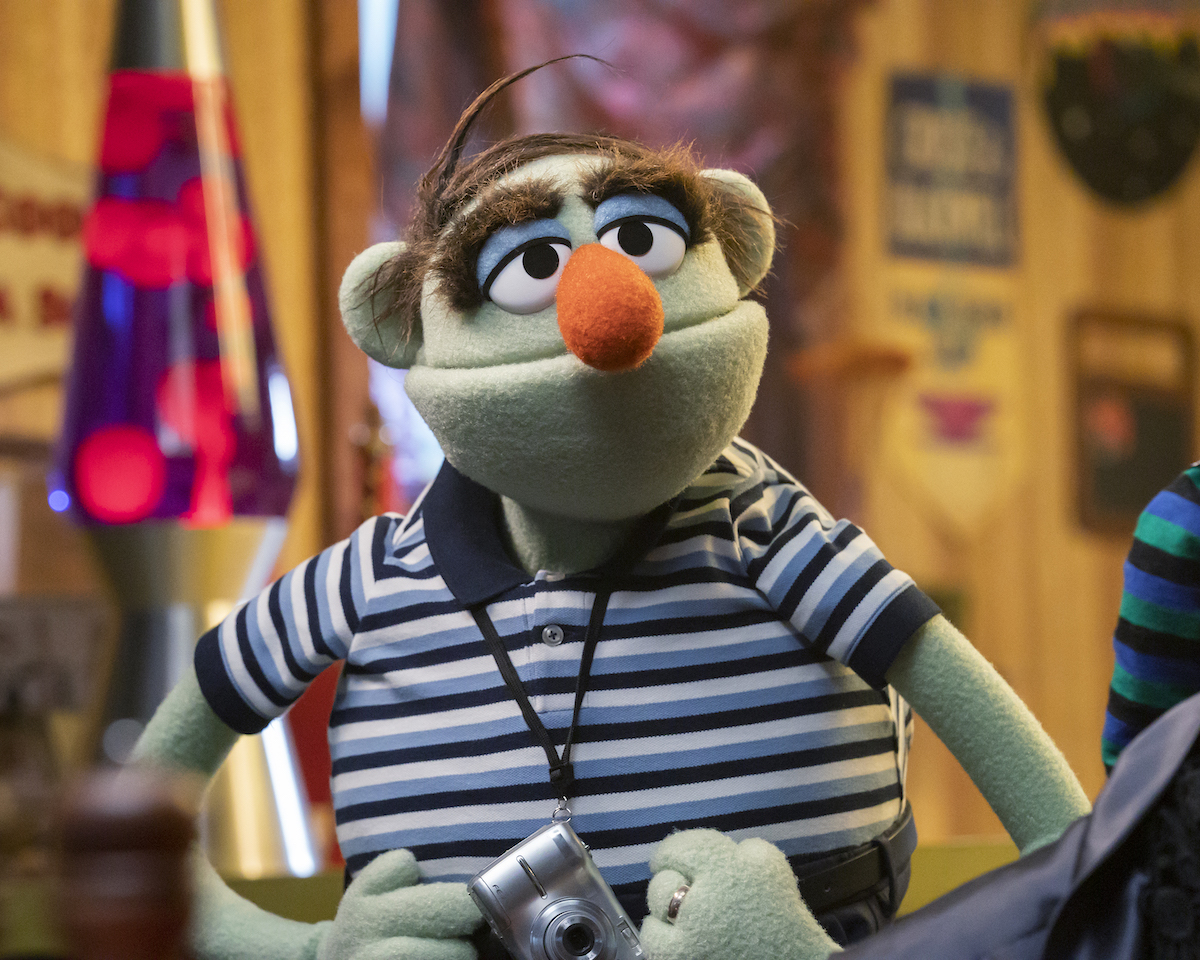
Rebecca Oliver Kaplan: How did you come to be involved in The Muppets Mayhem?
David Bizzaro: A little over a year ago, I played Mochi on Waffles + Mochi’s Restaurant, the latest season of the [Netflix show], and while shooting that, I got an invitation to audition for the character [of Gerald Teeth].
An audition for Muppets is unlike most puppetry auditions — in general, when you audition for a character in puppetry, they will ask you to put a puppet up on camera and perform the character you’re reading for, just like you would any other audition. But what’s unique for Muppets Mayhem, they’re reaching out to who they believe are skilled puppeteers, so they don’t need to see the technical side of your performance. Instead, they’re looking for your acting side, which I appreciated as a puppeteer trained in Muppets-style puppetry. Having attended the Sesame Street Workshop and the Jim Henson Puppetry Workshop, I learned that if they’re concerned about seeing an alive, three-dimensional character, your acting always comes first, and your character technique comes afterward.
For the audition, Bill Barretta was the one who initially reached out to me so they could see what sort of character I’d bring to the table, and so I gave them three interpretations of the character. Of course, they liked one more than the other. And so after that, we met and nailed down the character together, but that’s how I landed that role.
Kaplan: How is Muppets-style puppetry different from other styles?
Bizzaro: That’s a good question. When I say I’m a puppeteer, many people say, “Oh, like Marionettes?” While Marionettes are puppetry, there are a lot of different forms. You’re probably used to seeing the puppeteer when they’re performing or seeing a sort of stand-up stages, like Punch and Judy, some of the first well-documented puppetry. You see this tiny stage and little puppets come up into the proscenium, which is also a term used in theater, and it’s the big open window where you see the stage and the characters.
Puppetry was used in television before Jim Henson started working in TV, but how it was approached was similar to that on the stage. They’d have a tiny proscenium built up, and the puppet would come into the proscenium where it would play, and the camera would shoot that. But what Henson did that was different from what everybody else was doing was that he looked at the TV itself as the proscenium — from the tiny box window where you see the puppet — and so because he did that, you could shoot puppets in a more cinematic way and make them appear to exist within the real world.
You’ll hear some people call it “below the frame puppetry,” where the performer performs below the frame, and below the frame is a reference to the TV screen. Whenever you see characters up on the screen — like if you see seven characters, then that means that there are seven to 12 people below the frame, performing all those characters — there’s a massive group of adults with little tiny dolls above their heads, putting them up into the frame. And so, in essence, that’s Muppets-style puppetry. That’s how it started, and it’s become more defined and refined over the years.
One of the ways that I learned TV-style puppetry is from someone who had worked with Henson, but they had their stylistic approach. You see that with Muppets-style puppetry, also called arm and rod puppetry, you see people trying to work toward presenting their style to separate themselves from what’s considered Muppets-style puppetry, and that’s good. It’s like painting, where Impressionists try to put their spin on the style to stand out and make their mark, or it’s like dance, where you either have Martha Graham‘s technique or someone else’s school of thought. There are different approaches to the overall performance style of puppetry. But, when it comes to Muppets-style puppetry, as a whole, it refers to putting an arm and rod puppet in front of a camera and using that TV screen as your proscenium.
Kaplan: Is it like ballet?
Bizzaro: Yes, exactly like that.
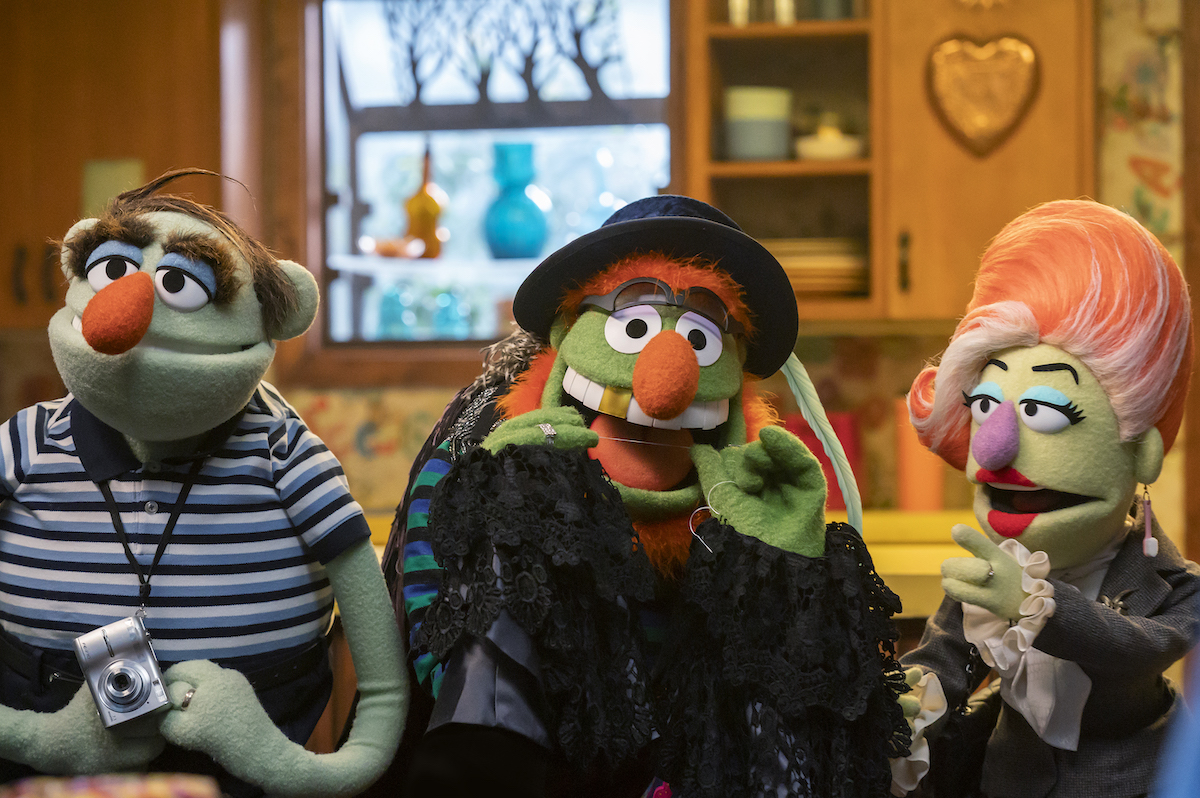
Kaplan: Is puppetry a newer art form? As an art form, it seems like it’s still developing these break-off techniques.
Bizzaro: TV-style puppetry, like The Muppets, is one of the newer popular forms, but puppetry itself has been around for a long time. There are artifacts of very, very old puppets that early humans were using, so puppetry is a method of storytelling that has been around for a very long time. But our current style is becoming a huge international success and is fairly young. So, there is much opportunity to invent, explore, and discover new methods.
Kaplan: Are there different challenges when puppeteering a small puppet, like Mochi, versus a larger puppet, like Gerald?
Bizzaro: Oh, my gosh, yes. Mochi is super small. He’s almost the size of a tennis ball and has no arms or legs. I was used to performing puppets like Gerald. Performing Mochi was new, so they gave me a puppet to take home and practice with. I had to explore and figure out how to convey movement with this character. It is a lot like dancing with a puppet. You’re creating the illusion of life since puppets don’t have muscles and the ability to move like humans or animals, so you use dance and mime to telegraph [what the puppet is doing].
The way I made Mochi telegraph he was angry, I would use his body, which was very soft, and pull down on the rod so that he gets squished. And because he was so small, if I was doing a sad or emotional moment, and the camera was close up, I couldn’t make a big movement with him. Instead, it had to be super subtle because if I made a big sweeping gesture, he would look erratic, and the audience wouldn’t be able to see his face anymore. And so, there were several moments where I felt like I was moving in slow motion, and the puppet looked like it wasn’t moving at normal speed. And sometimes, it looked like it was moving quickly, but under the frame, I was moving pretty slowly to get the line out or to convey whatever emotion I was trying to convey.
But with Gerald, Gerald was huge. Gerald is probably the biggest character I’ve performed in a production before. He was very big and very heavy. To put it into context — if you took an iron, like an iron you iron your clothes with, and held it above your head, it is half the weight of Gerald. I have to do stuff where I’m holding this puppet above my head for a five-minute take, like when the character has to walk across the screen and deliver an impassioned monologue in the final bit of my episode.
What you don’t see in the final edit, because they cut it, is when Gerald and Tina walk through the crowd. We filmed in a real physical location. We couldn’t stand straight up to walk through the crowd. We had to sit on “rollies” with little wheels and a little cushion and scoot our butts across the ground. And so, I got this puppet above my head, and I’m rolling across the ground on my butt, surrounded by extras, and I have to make sure that this big puppet is next to his wife walking forward. On top of that, my co-star Stephanie is right next to me. She has an assist, and I have an assist (what they do is help us because the movements are complex). So four grown adults are trying to move these two big puppets through a crowd of extras, and it isn’t easy.
Kaplan: It must be a workout to hold a puppet above your head for five minutes. Do you prepare your body before a puppetry shoot?
Bizzaro: I have a physical therapist who I see before and after a shoot. She prepares my muscles, and I do particular exercises to prepare my body. And then, when I’m on the shoot, I have a workout routine every morning. It’s nothing major, but I’ll work out with my Theraband and get my shoulders and back warmed up and ready, and then I’ll do some yoga to stretch and stay limber. I have a whole regimen. One of my workouts that my physical therapist gave me is just holding a 35-pound kettlebell above my head and walking ten paces back and forth like three times, and that’s to build that endurance in my shoulder because it is about endurance when you’re performing. If your body isn’t prepared, like in ballet or dance, and you go into it, you will pull a muscle, mess up your joints, and something bad will happen. And so I do as much as possible to prepare my body for performance so I do not injure myself.
Kaplan: You must have a warm-up as well.
Bizzaro: Yeah, we have a warm-up. You have gotta warm up. I have injured myself from not prepping. It’s a difficult performance style and highly athletic.
Dr. Teeth is a little smaller than Gerald but still a substantial puppet. When you see him run across the screen, below the frame, Barretta, who performs him, is holding him above his head, and then, sometimes, he has to move his whole body across the stage to get that character out of the frame. It’s a total workout. After 12 hours of doing that, if you’re not taking care of your body, you’ll feel like an old man at the end of the day.
Kaplan: I think many people probably don’t think about that. I mean, I never really thought about it.
Bizzaro: I don’t think that’s any fault to you or anyone that watches it. When I first started watching puppetry on TV, I didn’t think of that either, and I was completely swept up by the magic I saw in front of me. But when you see it in person, like when you watch people perform, you start to see how much of an athletic endeavor it is, and it’s incredible some of the stuff they do. They don’t have a raised stage on Sesame Street, and it’s all on the ground. So the puppeteers are all sitting the whole time. I mean, it’s incredible. It’s magic.
https://www.instagram.com/p/Cp-sD6hL7g0/?utm_source=ig_web_copy_link&igshid=MzRlODBiNWFlZA==
Kaplan: On the website for your clothing brand, BZRO Clothing, you wrote that the stitching techniques used in Count Von Count’s construction are similar to those used in haute couture. What do you mean by that?
Bizzaro: So, haute couture. On the surface, it refers to specific houses of garment-making in France. But the techniques they use are all hand stitching, so everything made in haute couture is all hand stitched. No sewing machine has touched that garment. Everything on Elmo, or any of the puppets of Sesame Street, is hand-sewn or hand put together. It has to be done quickly but perfectly, I think, is the way it was said to me.
When I was working at the Jim Henson Company, there were maybe two or three stitches that I knew when I started, but that changed by the time I was done — they encourage you to learn when you’re working in the shop and want you to see how everything is done. Once, I noticed a stitch I’d seen in quilt making, like a cross-stitch but a little different. I asked what it was, and my mentor said, “I don’t know what it’s called. It’s like a cross-stitch. I saw this on the original Count when I was first restoring it, and I keep doing it the same way because this is how it was done.” However, I never connected these techniques with garment making because I was being taught this method to make puppets.
I started teaching myself to make clothing because, during the pandemic, New York City completely shut down. I lived in NYC then and had three jobs lined up that would get me through the rest of the year, and they all went overnight. Luckily, my wife still had her job and kept us afloat. She suggested that I use the time to take a break and do whatever it is that I want to do. I was making a jacket for a toilet paper roll puppet, then. I wanted to elevate it and make this beautiful, intricate jacket. After completing it, someone said, “You should make one I can buy from you. I really want this jacket.” It made me think that if I can do this for a puppet, I can do this for a person.
I started getting every book I could on garment construction and patterning garments. I even found a book on haute couture hand stitching. When I was looking through them, I started seeing every stitch I’d been taught in these pictures, and it blew my mind. As I got further into patterning garments, I started seeing the same methods that I learned in patterning the foam structure for a puppet, and because I noticed it, I started linking the two methods together.
With my clothing brand, I’m bringing in techniques I learned working at the Jim Henson Company and building my puppets into my garments. It’s fun.
Kaplan: What other Jim Henson Company techniques have you applied to BZRO Clothing?
Bizzaro: […] If I only have five people buy a pair of jeans from me, I will only make those five pairs of jeans. And because I have a limited amount of denim, I will try to use the denim in the most economical way possible, cutting patterns out to create fewer scraps of denim. Then, if I have scraps, I save all of them and try to use them in the next garment I make. This is a practice that I learned from working at the Jim Henson Company because the fabrics and foam that they use are extremely expensive. They’re much more expensive than what you would use in a basic garment, so we were taught ways to center patterns on the fabric so that we used every bit of the material we could. So, I’m using that as part of my sustainable practices in my clothing shop.
Kaplan: “Nice fabric” used in the Jim Henson Creature Shop?
Bizzaro: “Nice fabric” because it’s a type of fabric that is not produced anymore. It’s called Antron fleece, and the guy who made it stopped making it. There have been a lot of different mills that have tried to remake it, and it’s like $25 per yard.
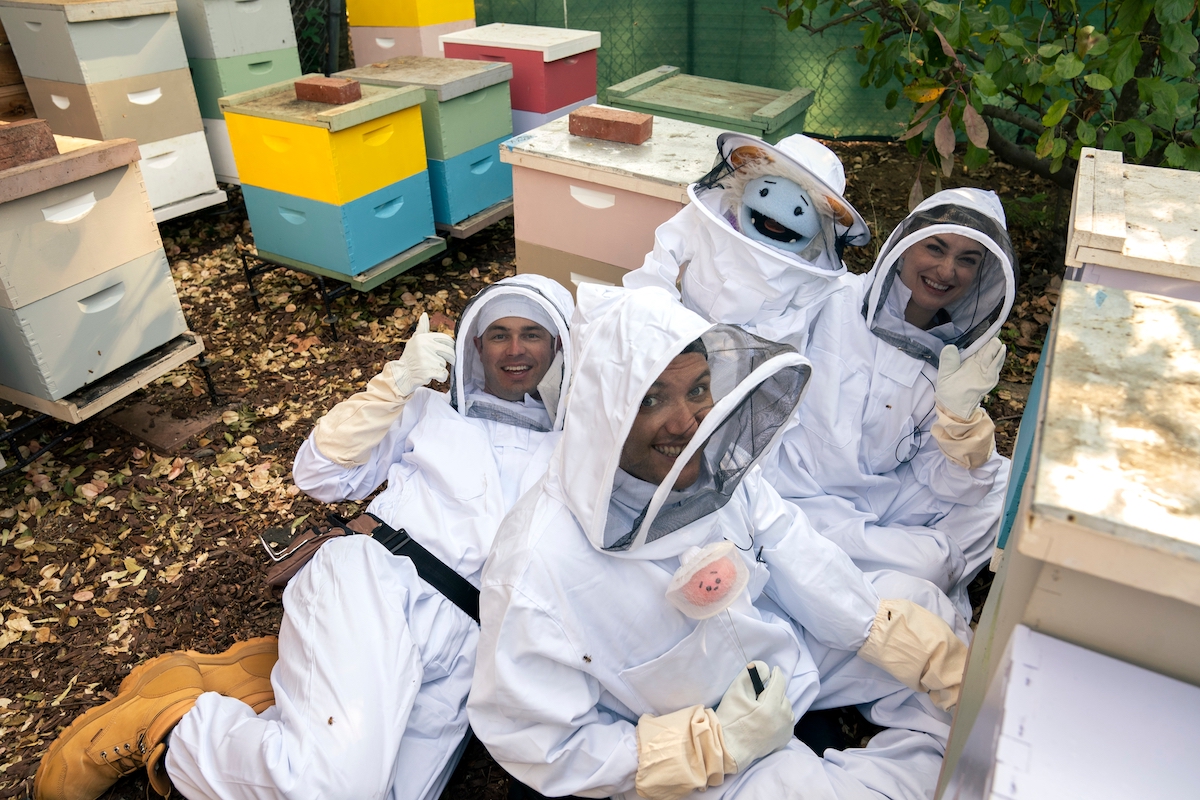
Kaplan: In one of your previous interviews, I saw that you were developing something with Steve Burns. Is that project still in the works?
Bizzaro: Yes, that is still in the works. We’ve been working on it for about four years, and it’s a wonderful concept. I love it. We had to slow down on it only because there’s a slowdown in the children’s media industry, and we don’t want to push our show on a production company that’s not interested in making any new shows right now. But we’re still working on it and talking to people who are interested in it.
Kaplan: Awesome news! Before we part ways, I want to know about your work with The Flaming Lips.
Bizzaro: My official title was Visual Generalist. I did anything and everything while working for them. I made background videos for their live shows, motion graphics for music videos, original art posters, art installations, and promotional materials like stickers and toys. I also went on tour with them, took photos of them, and did documentaries of them on the road. I did a documentary of Wayne screen-printing a poster with his blood, which was done cleanly. He hired a nurse who took the blood and was there while we printed the screen.
It was a good experience because I learned a method from the punk era of music-making that I quote a lot: “If you don’t have it, you don’t need it.” When we approached a project, like a music video or documentary, if we didn’t have the budget, like, “We don’t have it. We don’t need it. How can we accomplish that without it?” We would find ways to create our vision without using huge budgets, and I’ve turned that over into my own work. I learned that down-and-dirty production style from working for the Lips.
Kaplan: That was early in your career, right? How did your work with The Flaming Lips lead you toward puppetry?
Bizzaro: When I was working for The Flaming Lips — you know, in creative ventures, at least in my own life, it’s been my experience that there comes a certain point where you know that it’s time to shed that skin, to move on to something else, and I come to that place working for the Lips. Wade and I are still on good terms. He’s like a weird grandpa; sometimes, he’ll take a screenshot of my Instagram and send it to me. You can do a heart emoji, but it’s sweet. He’s always been encouraging of my art and journey.
With puppetry, I get to play all day.
Catch David Bizzaro as Gerald Teeth on The Muppets Mayhem, now streaming on Disney+.


